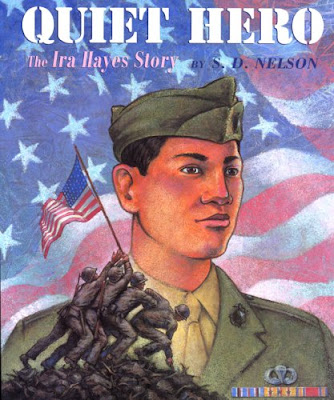Ira Hayes was a Pima Indian, born on the Gila River Indian Reservation in a remote part of the northern Sonoran Desert in Arizona in 1923. His family were poor farmer, working the land, but living without electricity or running water. They had four sons, and Ira was the oldest. He was quiet and shy, but always felt lonely and seemed to fit in with the other kids on the reservation or in the Phoenix Indian School when he was sent there.
But, while still in his teens, the Japanese attacked Pearl Harbor and the United States went to war. Ira felt it was his patriotic duty as an American to fight for his country and he joined the Marine Corps in August 1942 at age 19. Sent to basic training in San Diego, Ira didn't experience the kind of segregation and low level jobs reserved for the African American soldiers because many believed that Native Americans were fierce warriors and so they trained with the white soldiers.
After basic training, Ira volunteered to train as a Paramarine. Joining the military and going through such rigorous training seems for forge strong bonds of friendship among the soldiers, and it was in the Marines that Ira finally felt like he belonged. Ira and his fellow Marines arrived in the Pacific theater in March 1943 and fought there for two years. After the month long battle at Iwo Jima, Ira was one of six Marines who raised the flag over Mount Surabachi, a moment captured in a photograph by AP photographer Joe Rosenthal:
 |
| Iwo Jima - Ira Hayes is the last man on the left |
S. D. Nelson has written a very moving and insightful picture book for older readers about a real hero, showing us that even heroes aren't perfect. He could have easily written the Ira Hayes story up to the flag raising at Iwo Jima, and left it at that, but instead he chose to continue and let his readers see that heroes are human and sometimes flawed. Ira Hayes may have officially died of alcoholism, but I would say the loneliness, despair and depression were the real causes of his death.
Hayes' wartime experiences make up the majority of this book, but Nelson doesn't ignore his youth on the reservation and his time at the Indian School, giving us a clear picture of this very sensitive, isolated Pima Indian growing up in poverty, but surrounded by a loving family:
As you can see from the illustration above, Nelson's text is accompanied and complimented by his beautifully detailed acrylic illustrations using a widely varied palette of colors. And be sure to read the Author's Note at the back of the book, where he includes a more detailed account of the life of Ira Hayes, as well as very useful Bibliography for further investigation.
You can find an extensive Quiet Hero Teacher's Guide provided by the publisher, Lee & Low.
This book is recommended for readers age 8+
This book was borrowed from the NYPL



This sounds like a book about a person that should be celebrated. The illustrations look like they add a lot to the book. I am excited that the author's note adds so much. Thanks for sharing. :)
ReplyDelete